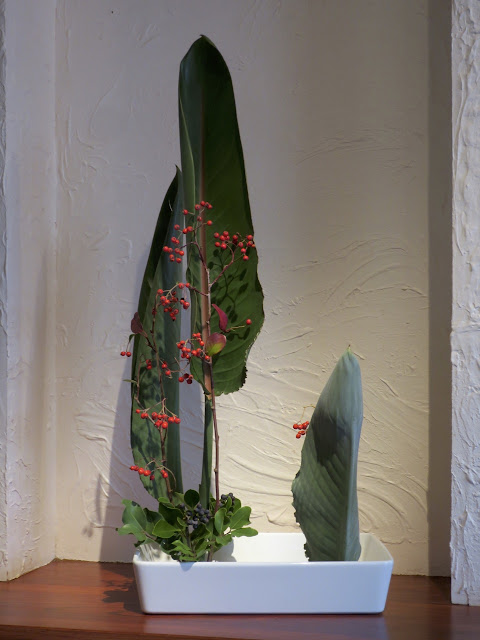The first of the workshops had the following theme: create an ikebana work that '...some would say, "You can't do that."...'. This is an interesting and perhaps slightly contradictory challenge, because freedom of expression for the individual ikebanist is encouraged in the Sogetsu School. We remember that our founder, Sofu Teshigahara, said that ikebana should be able to be made 'anywhere, by anyone, using any material'. The caveat, of course, is that the person has to have had an appropriate level of training.
This is the demonstration example that Mr Umemura made at the start of the workshop. He had made three almost circular shapes from disposable bamboo forks by glueing the tines together. After fixing them into a circular vase he then added fresh materials. Firstly green tortuous willow stems to make lines and, for a colour focus, petals from a bright red gerbera which he scattered on the moistened shapes. In this demonstration he was deliberately violating the idea that ikebana should not look like a work of 'handcraft'.
In thinking about this topic in advance I came up with a question that I had wondered about in the past. That is, how can one make a modern ikebana in a vessel that is profoundly historical in its form. I had in mind the classical bronze usubata vessels that I have only ever seen used for Rikka and Shoka arrangements. A couple of times I have seen people with no knowledge of ikebana buy such vessels as antique objects and then try to arrange flowers in them (with mixed or unconvincing results).
Interestingly, 18 months ago Laurie and I were given one such vase by a childhood friend of mine as a wedding present. My friend thought it was for burning incense. Now, I thought, I will have to see if I can find a way to make this work. In advance, my apologies to practitioners of the Ikenobo School for whom this vessel would have been made.
In my ikebana at the workshop I have used stems of Umbrella grass, cyperus alternifolius. I did three things that some people would say I should not do. The first is making a very spare, modern arrangement in a traditional vessel. The second is that I have deliberately placed some of the material on the table surface. The third is that I have made a reasonably close copy of an arrangement that Hiroshi Teshigahara made for one of the earliest printings of the third Sogetsu text book. His arrangement was illustrating the exercise of 'making a surface by massing lines'.
I was not displeased with the result. I am reminded of the way contrasts of modern and traditional aesthetics are successfully combined by greater artists than myself, such as the glass pyramid by I. M. Pei at the Louvre in Paris.
More photos from the workshop.
Greetings from Christopher
26th May 2019






















